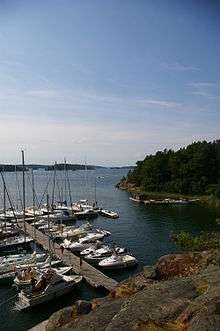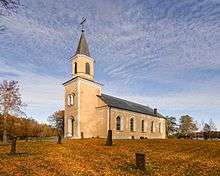Stockholm archipelago
The Stockholm archipelago, Stockholms skärgård or (locally) skärgården, is a group of thousands of islands in the Svealand region, extending east of Stockholm in the Baltic Sea. While many of the islands are relatively small, two large ones, Värmdö and Vaxholm, stand out as major destinations.
Understand
Since the Ice Age ended, the land has been rising from the Baltic Sea, changing the sceneries over generation; see Nordic countries#Geography.
In modern times, the archipelago consists of at least 24,000 identified islands, islets, and skerries.
From the Middle Ages until the end of the Cold War, the Swedish military has had troops, ships and fortifications in the archipelago, to defend Stockholm. The only major enemy attack on Stockholm was committed by the Russian Empire, in 1719 to 1721. Today, most defense facilities are closed down. The local population relied on subsistence fishing and farming, isolated from Stockholm's tremendous progress in the 19th century, as tourists started to colonize the area. During the 20th century, many of the outer islands were de-populated, and transformed to summer resorts, with very small population during winter. Today, most island-dwellers commute to Stockholm for work, and enjoy maritime life as a hobby. In contrast, many of the inner islands have become suburbs of Stockholm.
Tourist office
Islands and settlements


Just as the rest of Sweden, the Stockholm Archipelago is divided between municipalities, kommuner. From a traveller's point of view, the major islands are more useful as divisions.
- 🌍 Furusund — is an island where Astrid Lindgren, August Strindberg and many other writers and painters spent their summers. Also Norröra and Söderöra are in the same region, off Norrtälje.
- 🌍 Grinda — is a small rural island, near Stockholm and Vaxholm, good for a one-day excursion.
- 🌍 Lidingö — is a suburban island near Stockholm, described in its own article, together with Fjäderholmarna.
- 🌍 Ljusterö — is the largest island in the archipelago without a bridge to the mainland. It is served by a ferry from Östanå.
- 🌍 Sandhamn — is the largest island in the outer archipelago, known for its summer nightlife.
- 🌍 Utö — is an outer-archipelago idyllic island with a closed-down silver mine, and remnants from the mining industry. Do not confuse with Utö in Finland, across the sea.
- 🌍 Vaxholm — (archaic spelling Waxholm) is a quaint island-town connected to the mainland, with a historical fortress, a variety of boutiques, and a major ferry terminal to the northern archipelago.
- 🌍 Värmdö — (archaic spelling Wermdö) is the largest island in the archipelago, accessible by road. It contains suburban neighbourhoods as well as deep forests, lakes and beaches, similar to the Swedish mainland. Gustavsberg is the main town. Stavsnäs is a major ferry terminal for the southern archipelago.
- 🌍 Öja — is an elongated island, at the southern edge of the archipelago, off Nynäshamn. The Landsort lighthouse on Öja is an important landmark when arriving from Gotland.
Mainland settlements
This article also describes some mainland destinations associated with the archipelago.
- 🌍 Åkersberga — The entire Österåker municipality is included in this article, despite the fact that most of it is on the mainland. Österåker municipality's largest town is Åkersberga where also the municipal seat is located.
- 🌍 Saltsjöbaden — is a waterfront suburb for the well-to-do, at the end of Saltsjöbanan, a rail line from central Stockholm. It was built up around 1900, and is famous for its observatory, the Grand Hotel, and the acclaimed sitcom series Solsidan.
Get in
- See Stockholm County#Public transit for advice on public transport.
Most major islands can be reached on road (by car or bus), at some locations through free-ride car ferries.
Buses to the northern archipelago depart from Tekniska Högskolan (Östermalm). Buses to Värmdö depart from Slussen (Södermalm). Until 2023, the Slussen bus station is relocated to a temporary site outdoors, and the re-routing can cause congestion and delays. Buses for the southern archipelago depart from Gullmarsplan. See Stockholm#Public transport and the official public transport website:
However, for a good view, take a boat from central Stockholm, see below.
By ferry
The major shipping companies are the public-transport Waxholmsbolaget, and the private-owned Strömma, which runs Cinderellabåtarna. Waxholmsbolaget's regular boats depart from Strömkajen at the Grand Hotel. They stop at most docks, and tickets are comparably cheap.
Waxholmsbolaget also has two old-fashioned steamboats, mainly for slow dining cruises in the inner archipelago, or day-trips to Sandhamn.
Strömma is aimed at major tourist destinations, faster but costlier, often with a tour guide. Most of their boats depart from Nybrokajen at Nybroplan.
From April through September, numerous services operate directly from the city centre to various destinations, with Waxholmsbolaget departing from Strömkajen right downhill T Kungsträdgården, and Cinderellabåtarna departing from Nybrokajen, 400 m from T Östermalmstorg or T Kungsträdgården.
Other (and basically the only ones during winter) routes operate from suburban mainland jetties connected to central Stockholm by urban rail and bus, such as Vaxholm, reached by bus 670 from T Tekniska högskolan (Östermalm), Stavsnäs, reached by bus 433 or 434 from T-Slussen (Södermalm), and Gåshaga Brygga on Lidingö, reached by the Lidingöbanan rail line from T-Ropsten (Östermalm). Even during the summer, when many services operate from central Stockholm, transfer via a suburban jetty is usually both faster and cheaper. This is because even though the archipelago is within the metropolitan area, local transport tickets are not valid, and fares are based on distance. For multiple rides, you can buy a 5- or 30-day card (420 kr and 750 kr respectively), which belong to Waxholmsbolaget, but are also valid on Cinderellabåtarna.
Some destinations in the archipelago are Grinda, Svartsö, Finnhamn, Möja, Sandhamn, Ingmarsö, Runmarö, Nämdö and Utö. From April through September, most of these can be reached either from central Stockholm, or via suburban jetties. The islands offer a wide variety of nature, from the lush green of the inner archipelago to the bare cliffs of the more distant outposts. Some islands have restaurants, youth hostels and country stores, while others are entirely deserted islands.
A good destination for a day trip is Sandhamn, which is reached either by taking a direct ferry from the city centre (this takes 5 hr) or by taking the 433 or 434 bus from the centrally located T Slussen to Stavsnäs and from there a connecting ferry bound for Sandhamn or Hagede (from T Slussen this takes 90-95 min during summer and 110-115 min during winter). Waxholmsbolaget and Cinderellabåtarna serve both routes, but again, Cinderellabåtarna service is shut down during winter.
Utö makes another good trip and is accessible from the city centre (takes 3½ hr) or by taking suburban train from Stockholm Central Station to Västerhaninge, then bus 846 to Årsta Brygga and then a connecting ferry (from Stockholm C this takes 90 min during summer and 1 hr 45 min during winter). Both routes are served solely by Waxholmsbolaget.
The Baltic Sea ferries offer an elevated, comfortable view of the archipelago, though without the opportunity to set foot on any of them.
By yacht
- Main article: Boating on the Baltic Sea#Stockholm Archipelago
Private vessels are a good way to get around the archipelago. Due to the right of access, you can anchor and land nearly everywhere, as long as you respect local residents' privacy. There are thousands of islands that lack road or ferry connections, many of them with good natural harbours. Although most of those close to roads are full of summer cottages, others are there for you to explore. There are also many good marinas.
By bicycle
Cycling is a good option for some islands with proper roads.
See

While the major islands Värmdö, Ingarö and Ljusterö have rather mundane sceneries, similar to most of mainland Sweden, the more spectacular views are outside them, near the open sea; be sure to get out all the way. During summer, sailing boats add to the scenery.
- 🌍 Archipelago museum, Byholmsvägen 9 (In Stavsnäs, Värmdö), ☎ +46 8-571 502 14. Also has filials at Nämdö and Runmarö.
- 🌍 Artipelag, Artipelagstigen 1 (Gustavsberg, Värmdö), ☎ +46 8-570 130 00. An art gallery. Received the Swedish tourist award 2017.
- 🌍 Bogesund Palace (Bogesunds slott), Per Brahes väg (Vaxholm). A palace.
- 🌍 Finnhamn. A small village
- 🌍 Gustavsberg Porcelain Museum, Odelbergs väg 5. Reminds of the closed-down Gustavsberg porcelain factory.
- 🌍 Rydboholm Castle (Rydboholms slott) (Åkersberga). An old castle, once owned by the Swedish royal dynasty "Vasaätten".
- 🌍 Vaxholm Castle (Vaxholms fästning), ☎ +46 8-541 311 10. An old fortress which today contains a museum.
- 🌍 Wira Bruk, Bruksgårdsvägen 11 (Åkersberga). An ironworks founded in the 17th century, with a museum.
- 🌍 Värmdö Church, Värmdövägen 55-57, ☎ +46 8-574 009 40. A 14th-century church.
- 🌍 Ytterby. A mine on Resarö, with one unusual distinction: nine chemical elements of the periodic table were discovered here, four of them named by the settlement: yttrium, ytterbium, terbium and erbium.
Do
Outdoor life, especially water sport. Rod fishing is allowed without a license, as this is the sea, not freshwater lakes.
- 🌍 Saltsjöbaden observatory. Impressive from outside, though not usually open to the public.
- 🌍 Siggesta Gård, ☎ +46 8-562 801 20. Is a farming estate with several activities.
- Ötillö (literally "island to island"). Held on the first Monday of September. For hardcore swimmers Ötillö is an all-day swim-run race where teams of two swim between and run across many islands in the Stockholm archipelago. The swimming portions total 10 km and the running portions total 65 km. Ötillö is considered one of the toughest endurance races in the world.
Eat
- 🌍 Blidö Hamnkrog, Stämmarsundsvägen 7.
- 🌍 Fjäderholmarnas krog, Stora Fjäderholmen, ☎ +46 8-718 33 55.
- 🌍 Röda Villan, Stora Fjäderholmen, Stockholm, ☎ +46 8-21 50 31.
- 🌍 Sandhamnsrestaurangen, ☎ +46 8-574 504 00.
- 🌍 Sjöboden Torö, Ankarudden 3, Nynäshamn, ☎ +46 8-520 310 02.
- 🌍 Östanå Sjökrog, Grönborgsvägen 30, Ljusterö, ☎ +46 73-526 51 87.
Drink
Most boats in regular traffic have a simple bar, offering regular beer and wine.
Sleep
- 🌍 Nässlingen, ☎ +46 8 542 472 10, e-mail: info@nasslingen.se. Restaurant and guest house located on the island Nässlingen, near Ljusterö
- 🌍 Grinda Wärdshus, Södra Bryggan Grinda (Vaxholm), ☎ +46 8-542 494 91.
- 🌍 Gällnö Hotell & Vandrarhem (Gällnö), ☎ +46 8-571661, e-mail: info@gallno.se. Regularly listed as one of the best hostels in Sweden by the Swedish tourist association. The main building of is an old school-building, while the beds are located in cozy cabins. Open from the middle of May until the end of September.
- 🌍 Grand Hotel Saltsjöbaden, Hotellvägen 1, ☎ +46 8-506 170 00. A Grand Old Hotel, remembered in Swedish history for the 1938 Saltsjöbaden Agreement, Saltsjöbadsavtalet, an agreement between employers and unions to ensure peace on the labour market.
- 🌍 Waxholms Hotell, Hamngatan 2 (Vaxholm), ☎ +46 8-541 301 50.
- 🌍 Wermdö Golf & Country Club, Torpavägen 7, ☎ +46 8-574 607 00.
Stay safe
Ticks, fästingar, are common in grassy areas of the archipelago. Check your body and your pets every evening.